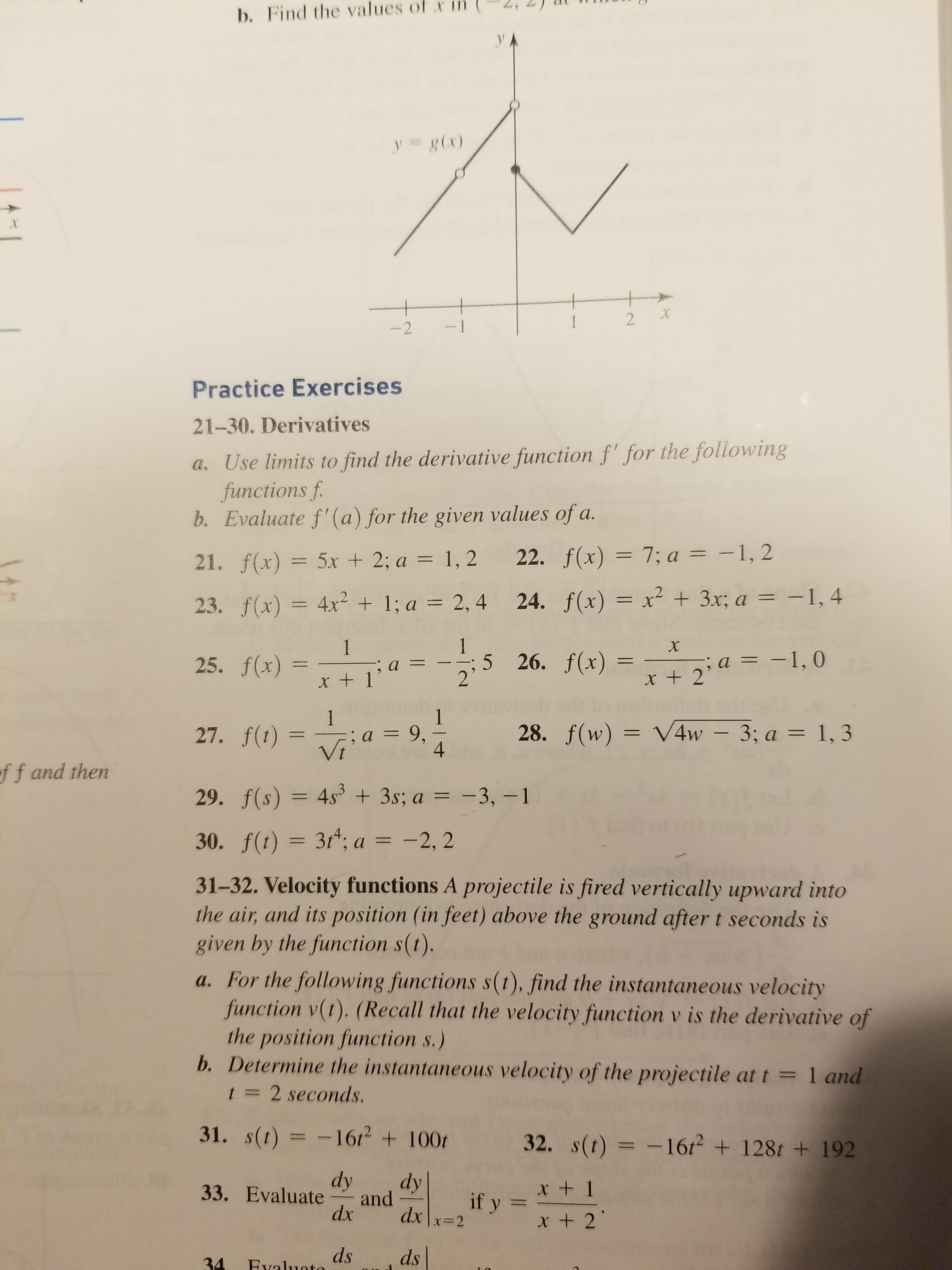b. Find the values of xin (2, 2) l y - gx) Practice Exercises 21-30. Derivatives a. Use limits to find the derivative function f for the following functions f b. Evaluate f'(a) for the given values of a. 21. f(x) 5x +2: a 1,2 22. fx) 7:a1,2 23. fx)42+1: a 2,4 24. fx)3x: a1.4 25. 26.x)2:a 1.0 x + 1 x+ 2 27, f(t) =-; a = 9, 28, f(w) = V4w-3; a = 1,3 f f and then 29. f(s) 4s + 3s; a 3,-1 30. f(t) = 3t4; a =-2,2 31-32. Velocity functions A projectile is fired vertically upward into the air, and its position (in feet) above the ground after t seconds is given by the function s(t). a. For the following functions s(t), find the instantaneous velocity function v(1). (Recall that the velocity function v is the derivative of the position fiunction s.) b. Determine the instantaneous velocity of the projectile at t 31. s()1612 100 32. s(t)1612 128t + 192 33. Evaluate rand Lifys_ 34dnds 1 and 1 2 seconds. dy dy x+ 1 x 2
b. Find the values of xin (2, 2) l y - gx) Practice Exercises 21-30. Derivatives a. Use limits to find the derivative function f for the following functions f b. Evaluate f'(a) for the given values of a. 21. f(x) 5x +2: a 1,2 22. fx) 7:a1,2 23. fx)42+1: a 2,4 24. fx)3x: a1.4 25. 26.x)2:a 1.0 x + 1 x+ 2 27, f(t) =-; a = 9, 28, f(w) = V4w-3; a = 1,3 f f and then 29. f(s) 4s + 3s; a 3,-1 30. f(t) = 3t4; a =-2,2 31-32. Velocity functions A projectile is fired vertically upward into the air, and its position (in feet) above the ground after t seconds is given by the function s(t). a. For the following functions s(t), find the instantaneous velocity function v(1). (Recall that the velocity function v is the derivative of the position fiunction s.) b. Determine the instantaneous velocity of the projectile at t 31. s()1612 100 32. s(t)1612 128t + 192 33. Evaluate rand Lifys_ 34dnds 1 and 1 2 seconds. dy dy x+ 1 x 2
Functions and Change: A Modeling Approach to College Algebra (MindTap Course List)
6th Edition
ISBN:9781337111348
Author:Bruce Crauder, Benny Evans, Alan Noell
Publisher:Bruce Crauder, Benny Evans, Alan Noell
Chapter1: Functions
Section1.2: Functions Given By Tables
Problem 32SBE: Does a Limiting Value Occur? A rocket ship is flying away from Earth at a constant velocity, and it...
Related questions
Topic Video
Question
For number 27, I understand the basic setup, but I'm unsure of what to do after I write out derivative function.

Transcribed Image Text:b. Find the values
of
xin
(2,
2)
l
y - gx)
Practice Exercises
21-30. Derivatives
a. Use limits to find the derivative function f for the following
functions f
b. Evaluate f'(a) for the given values of a.
21. f(x) 5x +2: a 1,2 22. fx) 7:a1,2
23. fx)42+1: a 2,4 24. fx)3x: a1.4
25.
26.x)2:a 1.0
x + 1
x+ 2
27,
f(t) =-; a = 9,
28, f(w) = V4w-3; a = 1,3
f
f and then
29. f(s) 4s + 3s; a 3,-1
30. f(t) = 3t4; a =-2,2
31-32. Velocity functions A projectile is fired vertically upward into
the air, and its position (in feet) above the ground after t seconds is
given by the function s(t).
a. For the following functions s(t), find the instantaneous velocity
function v(1). (Recall that the velocity function v is the derivative of
the position fiunction s.)
b. Determine the instantaneous velocity of the projectile at t
31. s()1612 100 32. s(t)1612 128t + 192
33. Evaluate rand Lifys_
34dnds
1 and
1 2 seconds.
dy dy
x+ 1
x 2
Expert Solution
This question has been solved!
Explore an expertly crafted, step-by-step solution for a thorough understanding of key concepts.
This is a popular solution!
Trending now
This is a popular solution!
Step by step
Solved in 3 steps with 3 images

Knowledge Booster
Learn more about
Need a deep-dive on the concept behind this application? Look no further. Learn more about this topic, calculus and related others by exploring similar questions and additional content below.Recommended textbooks for you

Functions and Change: A Modeling Approach to Coll…
Algebra
ISBN:
9781337111348
Author:
Bruce Crauder, Benny Evans, Alan Noell
Publisher:
Cengage Learning

Functions and Change: A Modeling Approach to Coll…
Algebra
ISBN:
9781337111348
Author:
Bruce Crauder, Benny Evans, Alan Noell
Publisher:
Cengage Learning